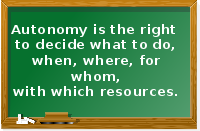Machines and autonomy: a topic that has arisen since the early 1900s in debate, philosophical discussions, academic writing and literature. And, of course, stories and movies. User-centered innovation employs a pragmatic definition of ‘machine autonomy’. This definition supports the analysis of machines: how these behave in solutions in which many different humans and machines participate. In user-centered innovation: “Autonomy is the right to decide what to do, when, where, for whom, with which resources.”
This definition of ‘machine autonomy’ follows the pragmatic observation that quite a large number of the machines that we interact with, are outside our immediate control (even more so in internet-based and cloud-based environments) and may be governed by other legal entities (sometimes residing in different countries). Machines may be complicated devices that exhibit complicated, perhaps even complex, behaviour. For our purposes, we sidestep the (interesting) question whether a machine can be autonomous. Rather, we pragmatically observe that at the very least machines are ‘relatively autonomous’ in relation to participants in a solution: The participants interact with the machines, and do not necessarily have full control of a machine, do not necessarily fully understand how a machine behaves, and may be surprised by the machine’s possible behaviour.
A trivial example of unexpected machine behaviour is whenever a failure (a ‘bug’) occurs: the machine starts to behave outside its previously specified behavioural pattern. It is often not apparent whether a failure has occurred, or a more richer behaviour pattern emerges as may be the case with learning algorithms. Although the reasons for a failure or new behaviour may be understandable by someone, it may not necessarily be understandable by the humans and machines that currently interact with that machine.
Current technology has many solutions to decrease dependencies between interacting machines. The effect is that whenever one of the machines ‘fails’ or ‘behaves unexpectedly’, the other interacting machines do not necessarily also ‘fail’ or ‘behave unexpectedly’. One often used principle is ‘loose coupling’, which is applied in (for example) service-oriented architectures, peer-to-peer architectures and multi-agent architectures.
In short, in user-centered innovation we pragmatically assume that machines have autonomy. Machines also have desired added-value (although that ‘desire’ may be hard-coded by programmers) and machines deliver added-value.
A non-exhaustive list of starting points to read more on machine autonomy:
- Overview of the concept of Autonomy on Wikipedia.
- Dictionary definition of Autonomy on Wiktionary.
- On loose coupling which comes from organisational theory and its application to computer-system design, see on Wikipedia.
- On autonomous software (‘multi-agent systems’) on Wikipedia.
- On peer-to-pear networks of machines on Wikipedia.
- Whether machines can have ‘autonomy’ is a question related to the strong claim of artificial intelligence, see on Wikipedia.





